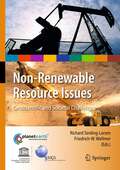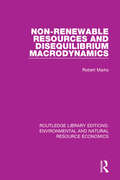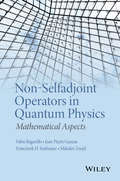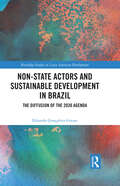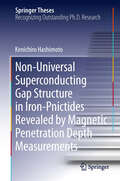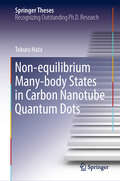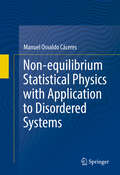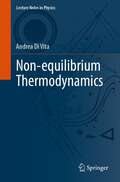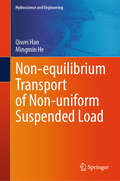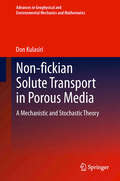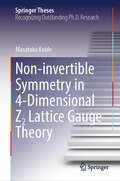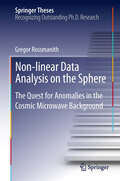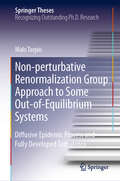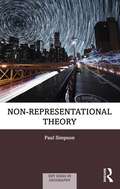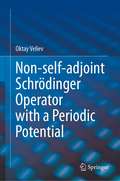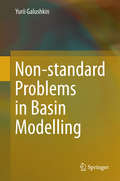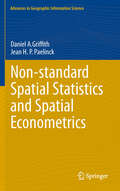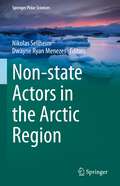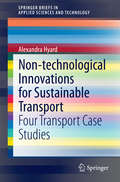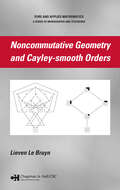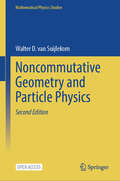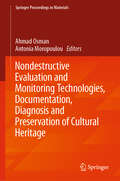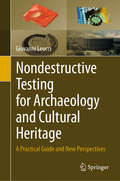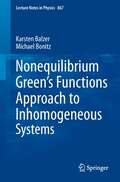- Table View
- List View
Non-Renewable Resource Issues
by Richard Sinding-Larsen Friedrich-W. WellmerAll the solid fuels fossil energy and mineral commodities we use come out of the Earth. Modern society is increasingly dependent on mineral and fossil energy sources. They differ in availability, cost of production, and geographical distribution. Even if solid fuels, fossil energy resources and mineral commodities are non-renewable, the extracted metals can to a large extent be recycled and used again and again. Although the stock of these secondary resources and their use increases, the world still needs and will continue to need primary mineral resources for the foreseeable future. Growing demands have begun to restrict availability of these resources. The Earth is not running out of critical mineral resources - at least for the near future - but the ability to explore and extract these resources is being restricted in many regions by competing land use, as well as political and environmental issues. Extraction of natural resources requires a clear focus on sustainable development, involving economic, environmental and socio-cultural aspects. Although we do not know what the most important resources will be in 100 years from now, we can be quite certain that society will still need energy and a wide range of raw materials. These resources will include oil and gas, coal, uranium, thorium, geothermal, metallic minerals, industrial and specialty minerals, including cement, raw materials, rare-earth elements. A global approach for assessing the magnitude and future availability of these resources is called for - an approach that, with appropriate international collaboration, was started within the triennium of the International Year of Planet Earth. Some global mineral resource assessments, involving inter-governmental collaboration, have already been initiated. The International Year of Planet Earth helped to focus attention on how the geosciences can generate prosperity locally and globally, as well as sustainability issues in both developed and developing countries.
Non-Renewable Resources and Disequilibrium Macrodynamics (Routledge Library Editions: Environmental and Natural Resource Economics)
by Robert MarksThis study, first published in 1979, continues by examining the question of whether a competitive economy can efficiently allocate a stock of non-renewable natural resources through time. Long-run analyses of competitive economies with such resources have concluded that, without perfect foresight or a complete set of future markets extending infinitely far into the future, there is no economic mechanism to guarantee that the initial price is set so that the economy converges to the socially desirable path of balanced growth. This title will be of interest to students of environmental and natural resource economics.
Non-Selfadjoint Operators in Quantum Physics
by Franciszek Hugon Szafraniec Fabio Bagarello Jean-Pierre Gazeau Miloslav ZnojilA unique discussion of mathematical methods with applications to quantum mechanics Non-Selfadjoint Operators in Quantum Physics: Mathematical Aspects presents various mathematical constructions influenced by quantum mechanics and emphasizes the spectral theory of non-adjoint operators. Featuring coverage of functional analysis and algebraic methods in contemporary quantum physics, the book discusses the recent emergence of unboundedness of metric operators, which is a serious issue in the study of parity-time-symmetric quantum mechanics. The book also answers mathematical questions that are currently the subject of rigorous analysis with potentially significant physical consequences. In addition to prompting a discussion on the role of mathematical methods in the contemporary development of quantum physics, the book features: Chapter contributions written by well-known mathematical physicists who clarify numerous misunderstandings and misnomers while shedding light on new approaches in this growing area An overview of recent inventions and advances in understanding functional analytic and algebraic methods for non-selfadjoint operators as well as the use of Krein space theory and perturbation theory Rigorous support of the progress in theoretical physics of non-Hermitian systems in addition to mathematically justified applications in various domains of physics such as nuclear and particle physics and condensed matter physics An ideal reference, Non-Selfadjoint Operators in Quantum Physics: Mathematical Aspects is useful for researchers, professionals, and academics in applied mathematics and theoretical and/or applied physics who would like to expand their knowledge of classical applications of quantum tools to address problems in their research. Also a useful resource for recent and related trends, the book is appropriate as a graduate-level and/or PhD-level text for courses on quantum mechanics and mathematical models in physics.
Non-State Actors and Sustainable Development in Brazil: The Diffusion of the 2030 Agenda (Routledge Studies in Latin American Development)
by Eduardo Gonçalves GresseThis book investigates how non-state actors have become key drivers of the diffusion of the UN 2030 Agenda for Sustainable Development in Brazil. The UN ranks Brazil as the most biodiverse country in the world, but the country’s environment has never been under greater threat, with the rise of multiple crises bringing mounting challenges to socioeconomic development and environmental protection. As state support has fallen away, non-state actors have actively engaged and eventually mobilized other social actors towards the promotion of the SDGs and the implementation of the UN agenda. This book asks why it is that non-state actors have dedicated so much time, effort and resources to promote a non-binding agenda that was ratified by and is mainly assigned to state actors. Looking at the roles of academia, civil society, and the private sector, the book explores the different ways in which these social actors make sense of and translate the 2030 Agenda into practice within their respective local contexts. Drawing on extensive fieldwork, this book sheds light on a series of challenges, opportunities and contradictions within the global agenda and its implementation. Assessing what the Brazil case can teach us about the diffusion of the 2030 Agenda and the SDGs more broadly, this book will be of interest to academics in the field of Sustainable Development, Latin America Studies and Environmental Politics as well as sustainable development researchers and policy makers.
Non-Universal Superconducting Gap Structure in Iron-Pnictides Revealed by Magnetic Penetration Depth Measurements
by Kenichiro HashimotoIn this book the author presents two important findings revealed by high-precision magnetic penetration depth measurements in iron-based superconductors which exhibit high-transition temperature superconductivity up to 55 K: one is the fact that the superconducting gap structure in iron-based superconductors depends on a detailed electronic structure of individual materials, and the other is the first strong evidence for the presence of a quantum critical point (QCP) beneath the superconducting dome of iron-based superconductors. The magnetic penetration depth is a powerful probe to elucidate the superconducting gap structure which is intimately related to the pairing mechanism of superconductivity. The author discusses the possible gap structure of individual iron-based superconductors by comparing the gap structure obtained from the penetration depth measurements with theoretical predictions, indicating that the non-universal superconducting gap structure in iron-pnictides can be interpreted in the framework of A1g symmetry. This result imposes a strong constraint on the pairing mechanism of iron-based superconductors. The author also shows clear evidence for the quantum criticality inside the superconducting dome from the absolute zero-temperature penetration depth measurements as a function of chemical composition. A sharp peak of the penetration depth at a certain composition demonstrates pronounced quantum fluctuations associated with the QCP, which separates two distinct superconducting phases. This gives the first convincing signature of a second-order quantum phase transition deep inside the superconducting dome, which may address a key question on the general phase diagram of unconventional superconductivity in the vicinity of a QCP.
Non-equilibrium Many-body States in Carbon Nanotube Quantum Dots (Springer Theses)
by Tokuro HataThis book presents the first experiment revealing several unexplored non-equilibrium properties of quantum many-body states, and addresses the interplay between the Kondo effect and superconductivity by probing shot noise. In addition, it describes in detail nano-fabrication techniques for carbon nanotube quantum dots, and a measurement protocol and principle that probes both equilibrium and non-equilibrium quantum states of electrons. The book offers various reviews of topics in mesoscopic systems: shot noise measurement, carbon nanotube quantum dots, the Kondo effect in quantum dots, and quantum dots with superconducting leads, which are relevant to probing non-equilibrium physics. These reviews offer particularly valuable resources for readers interested in non-equilibrium physics in mesoscopic systems. Further, the cutting-edge experimental results presented will allow reader to catch up on a vital new trend in the field.
Non-equilibrium Statistical Physics with Application to Disordered Systems
by Manuel Osvaldo CáceresThis textbook is the result of the enhancement of several courses on non-equilibrium statistics, stochastic processes, stochastic differential equations, anomalous diffusion and disorder. The target audience includes students of physics, mathematics, biology, chemistry, and engineering at undergraduate and graduate level with a grasp of the basic elements of mathematics and physics of the fourth year of a typical undergraduate course. The little-known physical and mathematical concepts are described in sections and specific exercises throughout the text, as well as in appendices. Physical-mathematical motivation is the main driving force for the development of this text. It presents the academic topics of probability theory and stochastic processes as well as new educational aspects in the presentation of non-equilibrium statistical theory and stochastic differential equations.. In particular it discusses the problem of irreversibility in that context and the dynamics of Fokker-Planck. An introduction on fluctuations around metastable and unstable points are given. It also describes relaxation theory of non-stationary Markov periodic in time systems. The theory of finite and infinite transport in disordered networks, with a discussion of the issue of anomalous diffusion is introduced. Further, it provides the basis for establishing the relationship between quantum aspects of the theory of linear response and the calculation of diffusion coefficients in amorphous systems.
Non-equilibrium Thermodynamics (Lecture Notes in Physics #1007)
by Andrea Di VitaThe importance of thermodynamics, particularly its Second Principle, to all branches of science in which systems with very large numbers of particles are involved cannot be overstated. This book offers a panoramic view of non-equilibrium thermodynamics. Perhaps the two most attractive aspects of thermodynamic equilibrium are its stability and its independence from the specifics of the particular system involved. Does an equivalent exist for non-equilibrium thermodynamics? Many researchers have tried to describe such stability in the same way that the Second Principle describes the stability of thermodynamic equilibrium - and failed. Most of them invoked either entropy, or its production rate, or some modified version of it. In their efforts, however, those researchers have found a lot of useful stability criteria for far-from-equilibrium states. These criteria usually take the form of variational principles, in terms of the minimization or maximization of some quantity. The aim of this book is to discuss these variational principles by highlighting the role of macroscopic quantities. This book is aimed at a wider audience than those most often exposed to the criteria described, i.e., undergraduates in STEM, as well as the usual interested and invested professionals.
Non-equilibrium Transport of Non-uniform Suspended Load (Hydroscience and Engineering)
by Qiwei Han Mingmin HeThe book is based on stochastic theory of sediment motion, particularly the theory of transition intensities. It provides a complete theory and equation system of non-equilibrium transport of non-uniform suspended load. The content proposed theory reports, for the first time in literature, the general boundary condition of diffusion equations of non-equilibrium transport with transition intensities. The book also introduces the theoretical expressions of size distribution of the carrying sediment capacity, efficient bed material grade, and saturation recovery coefficient This book describes the application of non-equilibrium transport theory and provides solutions to some long-standing unsolved controversial problems related to sediment transport. It establishes a generic mathematic model of reservoir sedimentation and river channel evolution; illustrates the same transport regulars of wash load and bed material load; demonstrates the multi-valued nature of carrying-sediment capacity and its single-valued consideration; and describes the mechanism of bed material coarsening. This book is of interest to a wide audience including students, technicians, and academics, primarily working in the field of river hydra-dynamics. In addition, this book receives attention from the research community working in fields, such as hydrogeology, hydraulic engineering, river navigation, wastewater treatment, and environmental protection
Non-fickian Solute Transport in Porous Media
by Don KulasiriThe advection-dispersion equation that is used to model the solute transport in a porous medium is based on the premise that the fluctuating components of the flow velocity, hence the fluxes, due to a porous matrix can be assumed to obey a relationship similar to Fick's law. This introduces phenomenological coefficients which are dependent on the scale of the experiments. This book presents an approach, based on sound theories of stochastic calculus and differential equations, which removes this basic premise. This leads to a multiscale theory with scale independent coefficients. This book illustrates this outcome with available data at different scales, from experimental laboratory scales to regional scales.
Non-fickian Solute Transport in Porous Media: A Mechanistic and Stochastic Theory (Advances in Geophysical and Environmental Mechanics and Mathematics)
by Don KulasiriThe advection-dispersion equation that is used to model the solute transport in a porous medium is based on the premise that the fluctuating components of the flow velocity, hence the fluxes, due to a porous matrix can be assumed to obey a relationship similar to Fick’s law. This introduces phenomenological coefficients which are dependent on the scale of the experiments. This book presents an approach, based on sound theories of stochastic calculus and differential equations, which removes this basic premise. This leads to a multiscale theory with scale independent coefficients. This book illustrates this outcome with available data at different scales, from experimental laboratory scales to regional scales.
Non-invertible Symmetry in 4-Dimensional Z2 Lattice Gauge Theory (Springer Theses)
by Masataka KoideThis book provides a method for concretely constructing defects that represent non-invertible symmetries in four-dimensional lattice gauge theory. In terms of generalized symmetry, a symmetry is considered to be equivalent to a topological operator whose value does not change even if the shape is topologically transformed. Even for models that lack symmetry in the traditional sense and are difficult to analyze, it is possible to analyze them as long as a generalized symmetry exists. Therefore, generalized symmetry is important for the non-perturbative analysis of quantum field theory. Some topological operators have no group structure, and the corresponding symmetries are called non-invertible symmetries. Concrete examples of non-invertible symmetries in higher-dimensional theories were discovered around 2020, and they have been actively studied as a field of generalized symmetries since then. This book explains the non-invertible symmetry represented by the Kramers-Wannier-Wegner duality, which was found firstly in a four-dimensional theory, represented by three-dimensional defects. This book is intended for those with preliminary knowledge of quantum field theory and statistical mechanics.
Non-linear Data Analysis on the Sphere
by Gregor RossmanithThis work deals with the search for signatures of non-Gaussianities in the cosmic microwave background (CMB). Probing Gaussianity in the CMB addresses one of the key questions in modern cosmology because it allows us to discriminate between different models of inflation, and thus concerns a fundamental part of the standard cosmological model. The basic goal here is to adapt complementary methods stemming from the field of complexity science to CMB data analysis. Two key concepts, namely the method of surrogates and estimators for local scaling properties, are applied to CMB data analysis. All results show strong non-Gaussianities and pronounced asymmetries. The consistency of the full sky and cut sky results shows convincingly for the first time that the influence of the Galactic plane is not responsible for these deviations from Gaussianity and isotropy. The findings seriously call into question predictions of isotropic cosmologies based on the widely accepted single field slow roll inflation model.
Non-perturbative Renormalization Group Approach to Some Out-of-Equilibrium Systems: Diffusive Epidemic Process and Fully Developed Turbulence (Springer Theses)
by Malo TarpinThis thesis presents the application of non-perturbative, or functional, renormalization group to study the physics of critical stationary states in systems out-of-equilibrium. Two different systems are thereby studied. The first system is the diffusive epidemic process, a stochastic process which models the propagation of an epidemic within a population. This model exhibits a phase transition peculiar to out-of-equilibrium, between a stationary state where the epidemic is extinct and one where it survives. The present study helps to clarify subtle issues about the underlying symmetries of this process and the possible universality classes of its phase transition. The second system is fully developed homogeneous isotropic and incompressible turbulence. The stationary state of this driven-dissipative system shows an energy cascade whose phenomenology is complex, with partial scale-invariance, intertwined with what is called intermittency. In this work, analytical expressions for the space-time dependence of multi-point correlation functions of the turbulent state in 2- and 3-D are derived. This result is noteworthy in that it does not rely on phenomenological input except from the Navier-Stokes equation and that it becomes exact in the physically relevant limit of large wave-numbers. The obtained correlation functions show how scale invariance is broken in a subtle way, related to intermittency corrections.
Non-representational Theory (Key Ideas in Geography)
by Paul SimpsonNon-representational Theory explores a range of ideas which have recently engaged geographers and have led to the development of an alternative approach to the conception, practice, and production of geographic knowledge. Non-representational Theory refers to a key body of work that has emerged in geography over the past two and a half decades that emphasizes the importance of practice, embodiment, materiality, and process to the ongoing formation of social life. This title offers the first sole-authored, accessible introduction to this work and its impact on geography. Without being prescriptive the text provides a general explanation of what Non-representational Theory is. This includes discussion of the disciplinary context it emerged from, the key ideas and themes that characterise work associated with Non-representational Theory, and the theoretical points of reference that inspires it. The book then explores a series of conjunctions of ‘Non-representational Theory and...’, taking an area of geographic enquiry and exploring the impact Non-representational Theory has had on how it is researched and understood. This includes the relationships between Non-representational Theory and Practice, Affect, Materiality, Landscape, Performance, and Methods. Critiques of Non-representational Theory are also broached, including reflections on issues on identity, power, and difference. The text draws together the work of a range of established and emerging scholars working on the development of non-representational theories, allowing scholars from geography and other disciplines to access and assess the animating potential of such work. This volume is essential reading for undergraduates and post-graduate students interested in the social, cultural, and political geographies of everyday living.
Non-self-adjoint Schrödinger Operator with a Periodic Potential
by Oktay VelievThis book gives a complete spectral analysis of the non-self-adjoint Schrödinger operator with a periodic complex-valued potential. Building from the investigation of the spectrum and spectral singularities and construction of the spectral expansion for the non-self-adjoint Schrödinger operator, the book features a complete spectral analysis of the Mathieu-Schrödinger operator and the Schrödinger operator with a parity-time (PT)-symmetric periodic optical potential. There currently exists no general spectral theorem for non-self-adjoint operators; the approaches in this book thus open up new possibilities for spectral analysis of some of the most important operators used in non-Hermitian quantum mechanics and optics. Featuring detailed proofs and a comprehensive treatment of the subject matter, the book is ideally suited for graduate students at the intersection of physics and mathematics.
Non-standard Problems in Basin Modelling
by Yurii GalushkinThis book details how the GALO system of basin modelling may be used in the analysis of actual, non-standard problems of geology. It begins by addressing the tectonic subsidence of sedimentary basins, and goes on to consider the problems of maturation of organic matter and hydrocarbon generation in the vicinity of intrusions and subtrappean sedimentary complexes. Lastly, the book discusses the formation of temperature and heat flow distributions with depth due to the sharp climate variations in the Quaternary, which was marked by repeated formation and degradation of permafrost. The book studies the application of the GALO basin modelling system to the three problems mentioned above. Employing the GALO system provides a unique opportunity to assess the amplitude and duration of the stretching and thermal activation of the basin lithosphere, and to study in detail the formation of a maturity aureole of organic matter in the basin's subtrappean sedimentary cover. This book offers a valuable resource for all graduate students and professionals interested in numerical modelling of the thermal evolution of sedimentary basins. It will also be of great interest to petroleum geologists engaged in oil and gas exploration in the trap provinces of the world. Lastly, it will benefit those students and geologists dealing with the thermal field of sedimentary blankets in actual and degraded permafrost areas.
Non-standard Spatial Statistics and Spatial Econometrics
by Daniel A. Griffith Jean H. PaelinckDespite spatial statistics and spatial econometrics both being recent sprouts of the general tree "spatial analysis with measurement"--some may remember the debate after WWII about "theory without measurement" versus "measurement without theory"--several general themes have emerged in the pertaining literature. But exploring selected other fields of possible interest is tantalizing, and this is what the authors intend to report here, hoping that they will suscitate interest in the methodologies exposed and possible further applications of these methodologies. The authors hope that reactions about their publication will ensue, and they would be grateful to reader(s) motivated by some of the research efforts exposed hereafter letting them know about these experiences.
Non-state Actors in the Arctic Region (Springer Polar Sciences)
by Nikolas Sellheim Dwayne Ryan MenezesThis book comprehensively discusses the role that non-state actors play in the Arctic and assesses the normative role of these actors. Beyond any organised forum, there are actors that have a significant impact on the way the Arctic is developed, adjudicated, managed, perceived, presented and represented. This book complements the literature on non-state actors in international law and international security, world politics and international relations and provides a geographical account of their role for the Arctic. The book content is not limited to a specific discipline, but takes into account different approaches to the topic. This means that it contains three types of contributions: research articles, shorter research notes and commentaries. While the research articles constitute the main body of the work, it is also the research notes which provide an insight into issues related to the topic of the book.
Non-technological Innovations for Sustainable Transport
by Alexandra HyardExamining non-technological innovations for environmentally and socially-friendly transport, this book provides the reader with a better understanding of this often overlooked topic. It features four illustrative case studies, and presents a concise review of the core transport modes (road, rail and marine transport). Transport companies are compelled to innovate due to economic and environmental pressures, and the aim of these innovations is to improve fuel efficiency and ultimately to transform energy use in the transport sector. Whilst many of these innovations are technological, they can conversely be non-technological in nature. This book is intended for students and researchers interested in economics, environmental economics and economics of innovation. It also offers a useful resource to industry professionals interested in ecology and transport.
Noncommutative Geometry and Cayley-smooth Orders
by Lieven Le BruynNoncommutative Geometry and Cayley-smooth Orders explains the theory of Cayley-smooth orders in central simple algebras over function fields of varieties. In particular, the book describes the etale local structure of such orders as well as their central singularities and finite dimensional representations.After an introduction to partial d
Noncommutative Geometry and Particle Physics (Mathematical Physics Studies)
by Walter D. van SuijlekomThis book provides an introduction to noncommutative geometry and presents a number of its recent applications to particle physics. In the first part, we introduce the main concepts and techniques by studying finite noncommutative spaces, providing a “light” approach to noncommutative geometry. We then proceed with the general framework by defining and analyzing noncommutative spin manifolds and deriving some main results on them, such as the local index formula. In the second part, we show how noncommutative spin manifolds naturally give rise to gauge theories, applying this principle to specific examples. We subsequently geometrically derive abelian and non-abelian Yang-Mills gauge theories, and eventually the full Standard Model of particle physics, and conclude by explaining how noncommutative geometry might indicate how to proceed beyond the Standard Model. The second edition of the book contains numerous additional sections and updates. More examples of noncommutative manifolds have been added to the first part to better illustrate the concept of a noncommutative spin manifold and to showcase some of the key results in the field, such as the local index formula. The second part now includes the complete noncommutative geometric description of particle physics models beyond the Standard Model. This addition is particularly significant given the developments and discoveries at the Large Hadron Collider at CERN over the last few years. Additionally, a chapter on the recent progress in formulating noncommutative quantum theory has been included. The book is intended for graduate students in mathematics/theoretical physics who are new to the field of noncommutative geometry, as well as for researchers in mathematics/theoretical physics with an interest in the physical applications of noncommutative geometry.
Nondestructive Evaluation and Monitoring Technologies, Documentation, Diagnosis and Preservation of Cultural Heritage (Springer Proceedings in Materials)
by Antonia Moropoulou Ahmad OsmanThis book highlights the benefits of Non-Destructive Testing (NDT) methods and their applications on several cultural heritage sites including the Holy Selphuchre Monitoring System in Jerusalem. This book demonstrates Nondestructive sensing technologies and inspection modules as main tools for documentation, diagnosis, characterization, preservation planning, monitoring and quality of restoration, assessment and evaluation of material and preservation work.
Nondestructive Testing for Archaeology and Cultural Heritage: A Practical Guide And New Perspectives
by Giovanni LeucciThis textbook provides a general introduction to the most important nondestructive testing (NDT) exploration methods for cultural heritage sites. It and highlights the application of NDT exploration methods to archaeology and monumental property. The ability to gauge the extent of an archaeological deposit or the state of preservation of artefacts without resorting to destructive actions is extremely useful in identifying unknown or potential artefacts, and can help to understand and approach a given site in a more targeted manner, both for excavation and restoration operations. This book describes the main physical principles, campaign procedures, and processing and interpretation techniques of NDT, while also introducing a new technique and algorithm for data acquisition and processing. A large section of the book is devoted to actual on-site applications, and focuses on significant historical-archaeological sites in Italy and Turkey. The book offers an essential reference guide for students and scientists in archaeology, geophysics, architecture, and the engineering disciplines, as well as specialists.
Nonequilibrium Green's Functions Approach to Inhomogeneous Systems
by Karsten Balzer Michael BonitzThis book offers a self-contained introduction to non-equilibrium quantum particle dynamics for inhomogeneous systems, including a survey of recent breakthroughs pioneered by the authors and others. The approach is based on real-time Green's functions.
